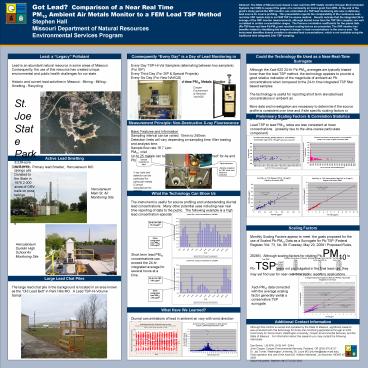48x48 Poster Template - PowerPoint PPT Presentation
1 / 1
Title:
48x48 Poster Template
Description:
PM10 Ambient Air Metals Monitor to a FEM Lead TSP Method Stephen Hall Missouri Department of Natural Resources Environmental Services Program Abstract: The State of ... – PowerPoint PPT presentation
Number of Views:58
Avg rating:3.0/5.0
Title: 48x48 Poster Template
1
Got Lead? Comparison of a Near Real Time PM10
Ambient Air Metals Monitor to a FEM Lead TSP
Method Stephen Hall Missouri Department of
Natural Resources Environmental Services Program
Abstract The State of Missouri purchased a near
real time XRF metals monitor (Cooper
Environmental Systems Xact 620) to support the
goals of a community air toxics grant from EPA.
At the end of the grants study period the XRF
monitor was collocated at a TSP lead monitoring
site near a stationary lead source for source
profiling. This presentation reports the
comparability of the continuous near-real time
XRF metals data to an FEM TSP hi-volume method.
Results indicate that the integrated 24-hr
average of the XRF monitor measurements, although
biased lower than the TSP 24hr samples, are well
correlated in certain concentration ranges. The
Pearson correlation coefficients for the paired
data (Pb-TSP/near-real time Pb-PM10) and
resultant scaling factors are presented. The XRF
monitor has benefits related to identifying the
temporal changes in lead concentrations in the
source area. The instrument identifies diurnal
variation in elevated lead concentrations, which
is not available using the traditional time
integrated 24hr TSP sampling.
Lead a Legacy Pollutant
Consequently Every Day is a Day of Lead
Monitoring in Missouri
Could the Technology Be Used as a Near-Real-Time
Surrogate for Pb-TSP?
Lead is an abundant natural resource in some
areas of Missouri. Consequently, the use of this
resource has created unique environmental and
public health challenges for our state. Historic
and current lead activities in Missouri Mining
- Milling - Smelting - Recycling
Every Day TSP-Hi-Vol Samplers (alternating
between two samplers) (For SIP) Every Third Day
(For SIP Special Projects) Every Six Day (For
New NAAQS) And Now-Every Hour! Near Real time
PM10 Metals Monitor
Although the Xact 620 24-Hr Pb-PM10 averages are
typically biased lower than the lead TSP method,
the technology appears to provide a good relative
indication of the magnitude of ambient air Pb
concentrations when compared to the 24-hr time
integrated TSP filter based samples. The
technology is useful for reporting short term
elevated lead concentrations in ambient
air. More data and investigation are necessary
to determine if the source profile is consistent
over time and if site specific scaling factors or
other statistical correction techniques could be
applied reliably to produce a TSP surrogate.
Cooper Environmental Services Xact-620
St. Joe State Park 8,238-acre lead mine tailings
site Donated to the State in 1976 2,000-acres of
ORV trails on mine tailings. Active SPMS
monitoring to measure Pb Ambient Air
concentrations
Preliminary Scaling Factors Correlation
Statistics
Lead TSP to lead PM10 ratios are less consistent
at lower concentrations. (possibly due to the
ultra-coarse particulate component)
Measurement Principle Non-Destructive X-ray
Fluorescence
Basic Features and Information Sampling interval
can be varied. 15min to 240min. Detection limits
will vary depending on sampling time, filter
loading and analysis time. Sample flow rate 16.7
Lpm PM10 inlet. Up to 25 metals can be measured.
(This monitor is tuned for As and Pb)
Active Lead Smelting
Sample Collected on tape
Doe Run Co. Primary lead Smelter, Herculaneum MO
-Tape advances -Sample analyzed by XRF while
next sample is collected.
X-ray tube and detector can be optimized for
particular metals. (Consult manufacture for
details)
Herculaneum Main St. Air Monitoring Site
What the Technology Can Show Us
The instrument is useful for source profiling and
understanding diurnal lead concentrations. Many
other potential uses including near real time
reporting of data to the public. The following
example is a high lead concentration episode on
December 23rd and 24th 2009.
24-Hr Pb-TSP 12.23 µg/m3
Scaling Factors
Monthly Scaling Factors appear to meet the goals
proposed for the use of Scaled Pb-PM10 Data as a
Surrogate for Pb-TSP (Federal Register /Vol. 73,
No. 98 /Tuesday, May 20, 2008 / Proposed Rules,
29285). Although scaling factors for relating
Pb-PM10 to Pb-TSP were not promulgated in the
final lead rule, they may yet find use for
near-real-time public reporting applications.
24-Hr Integrated Xact-PM10 8.40 µg/m3
Herculaneum Dunklin High School Air Monitoring
Site
Short term lead PM10 concentrations can exceed
the 24-hr integrated average for several hours at
a time.
Large Lead Chat Piles
24-Hr Pb-TSP 4.81 µg/m3
The large lead chat pile in the background is
located in an area known as the Old Lead Belt
in Park Hills MO. A Lead TSP-Hi-Volume Sampler
is in the foreground.
Xact-PM10 data corrected with the average scaling
factor generally yields a conservative TSP
surrogate.
24-Hr Integrated Xact-PM10 3.45 µg/m3
What Have We Learned?
Diurnal concentrations of lead in ambient air
vary with wind direction from the source.
Additional Contact Information
Although this monitor is owned and operated by
the State of Missouri, significant research was
conducted with this technology for fence-line
monitoring applications through an EPA Community
Air Toxics Grant, Washington University, Cooper
Environmental Services, and the State of
Missouri. For information about this research
you may contact the following individuals Dan
Bivins, US-EPA, (919) 541- 5244 John Cooper,
Cooper Environmental Services, Portland, OR (503)
670-8127 Dr. Jay Turner, Washington University,
St. Louis MO (jrturner_at_seas.wustl.edu) Field
operation and use of the Xact-620 William
Wetherell, Jim Burnnert, MDNR (573
)526-3359 About this poster Stephen Hall
573-526-3362






























